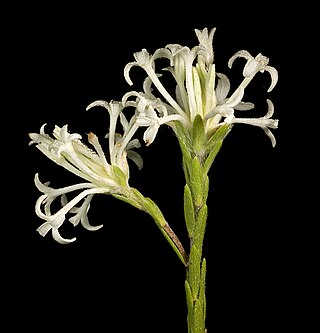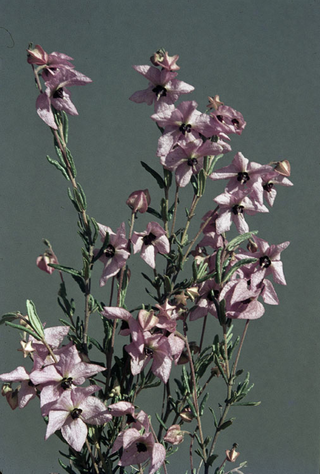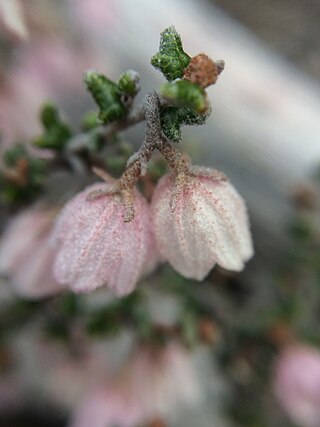
Guichenotia macrantha, commonly known as large-flowered guichenotia, is a species of flowering plant in the family Malvaceae. It is a shrub with grey-green leaves, mauve flowers and is endemic to Western Australia.

Pimelea longiflora is a species of flowering plant in the family Thymelaeaceae and is endemic to the southwest of Western Australia. It is an erect, spindly shrub with linear to narrowly elliptic leaves and erect clusters of white to cream-coloured flowers, surrounded by 4 to 6 green, egg-shaped involucral bracts.
Lasiopetalum lineare is a species of flowering plant in the family Malvaceae and is endemic to the south-west of Western Australia. It is an erect shrub with densely hairy young stems, linear leaves and bright pink and dark red flowers.

Stenanthemum emarginatum is a species of flowering plant in the family Rhamnaceae and is endemic to the southwest of Western Australia. It is a spreading to prostrate shrub with sparsely hairy young stems, narrowly fan-shaped to linear leaves and densely, shaggy-hairy heads of white or cream-coloured flowers.

Stenanthemum intricatum is a species of flowering plant in the family Rhamnaceae and is endemic to the southwest of Western Australia. It is an erect to spreading, often wiry shrub with sparsely hairy young stems, egg-shaped to fan-shaped leaves and greyish, densely softly-hairy heads of white or cream-coloured flowers.
Stenanthemum limitatum is a species of flowering plant in the family Rhamnaceae and is endemic to the southwest of Western Australia. It is an erect or straggling shrub with sparsely hairy young stems, egg-shaped to fan-shaped leaves and greyish, softly-hairy heads of white or cream-coloured flowers.

Guichenotia sarotes is a species of flowering plant in the family Malvaceae and is endemic to the southwest of Western Australia. It is a spindly, low-growing shrub with densely hairy new growth, hairy, greyish, linear leaves and pink to purple flowers arranged in loose groups of two to six.

Androcalva fragifolia is a species of flowering plant in the family Malvaceae and is endemic to the south-west of Western Australia. It is a straggling, prostrate shrub with glossy, broadly egg-shaped leaves, and creamy white flowers.
Guichenotia alba is a flowering plant in the family Malvaceae and is endemic to Western Australia. It is a slender, spreading shrub with lax, hairy young branches, leaves with the edges rolled under, and white flowers.

Guichenotia angustifolia is a species of flowering plant in the family Malvaceae and is endemic to the south-west of Western Australia. It is an erect, prostrate or climbing shrub with hairy young growth, hairy, oblong to linear leaves and pink to mauve flowers.
Guichenotia anota is a flowering plant in the family Malvaceae and is endemic to a restricted part of the southwest of Western Australia. It is a low, erect, compact shrub with hairy new growth, oblong to narrowly egg-shaped leaves, and pinkish-purple flowers.

Guichenotia apetala is a flowering plant in the family Malvaceae and is endemic to a small area in the southwest of Western Australia. It is a small, erect, compact shrub with many branches, densely hairy new growth, triangular to heart-shaped leaves, and salmon pink flowers.
Guichenotia asteriskos is a flowering plant in the family Malvaceae and is endemic to the southwest of Western Australia. It is a dwarf, spreading shrub with hairy new growth, linear to narrowly egg-shaped leaves, and white flowers.
Guichenotia astropletha is a flowering plant in the family Malvaceae and is endemic to the southwest of Western Australia. It is a dwarf, spreading shrub with hairy new growth, linear to narrowly egg-shaped leaves, and pink flowers.
Guichenotia basiviridis is a flowering plant in the family Malvaceae and is endemic to the far west of Western Australia. It is an erect, spreading shrub with hairy new growth, linear leaves with the edges rolled under, and pink flowers arranged in groups of three to seven.
Guichenotia glandulosa is a species of flowering plant in the family Malvaceae and is endemic to a small area in the south-west of Western Australia. It is a spreading, dwarf shrub with hairy new growth, more or less linear leaves with the edges turned down, and pink flowers arranged in groups of six or seven.
Guichenotia impudica is a species of flowering plant in the family Malvaceae and is endemic to the south-west of Western Australia. It is a spreading, dwarf shrub with hairy new growth, more or less linear leaves with the edges turned down, and pink flowers arranged in groups of six or seven.

Guichenotia micrantha, commonly known as small flowered guichenotia, is a species of flowering plant in the family Malvaceae and is endemic to the south-west of Western Australia. It is a low, compact shrub with linear to narrowly egg-shaped leaves and pink flowers in groups of three to six.
Guichenotia seorsiflora is a species of flowering plant in the family Malvaceae and is endemic to the south-west of Western Australia. It is a low, spreading, multi-stemmed shrub with linear to narrowly egg-shaped leaves and white flowers arranged singly in upper leaf axils.
Guichenotia tuberculata is a species of flowering plant in the family Malvaceae and is endemic to the south-west of Western Australia. It is a low, spreading shrub with linear to narrowly egg-shaped leaves and dark pink flowers arranged in groups of two to five.









